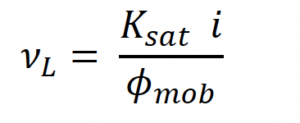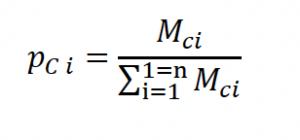Solution to Exercise 2
To complete these calculations, first calculate the average linear groundwater velocity (νL) as shown in the following equation, at the stream interface for both the high and low water scenarios in each peat layer.


Next, calculate the proportion of water (pw) flowing into the stream from each layer (i) as shown in this equation. In this case the sum of li is 150 cm.


Using a base concentration of 1 mg cm-3 for the maximum condition when Rf = 1, the amount of contaminant in a layer designated by i (Mci) exported to the stream is the product of the volumetric flow rate of the groundwater and the contaminant concentration which is assumed to be proportional to 1/Rf, as follows.
For an Rf = 3.2, the following expresses the mass of contaminant exported to the stream.

The proportion of contaminant (pc) flowing into the stream from each layer (i) is the quotient of the layer Mc and the sum of Mc for all layers.

The results are shown in the table below.

Under wet conditions, the decline in hydraulic conductivity and other hydraulic properties of peat within the upper 20 cm of the profile results in a smaller difference in proportion of water flux to the stream from the upper layers 1 and 2 (0.07) than contaminant flux (0.09). Even with a further decline in hydraulic conductivity and an increase in partitioning coefficient in the next peat layer (20 to 30 cm), the proportion of contaminant exiting to the stream from this third layer (0.19) is greater than the proportion of water flux from the layer (0.18). This suggests that hydraulic conductivity is a strong control on the export of this weakly adsorbing contaminant. If the partitioning coefficient was far larger, such as that of inorganic mercury (~103-5 mL g-1), the relatively small changes in hydraulic conductivity would not impact the total mass of contaminant exported to the stream to such a degree.
The lower saturated thickness under dry conditions (low water table) resulted in a decrease in contaminant export by more than an order of magnitude (267 g/d versus 18 g/d).
